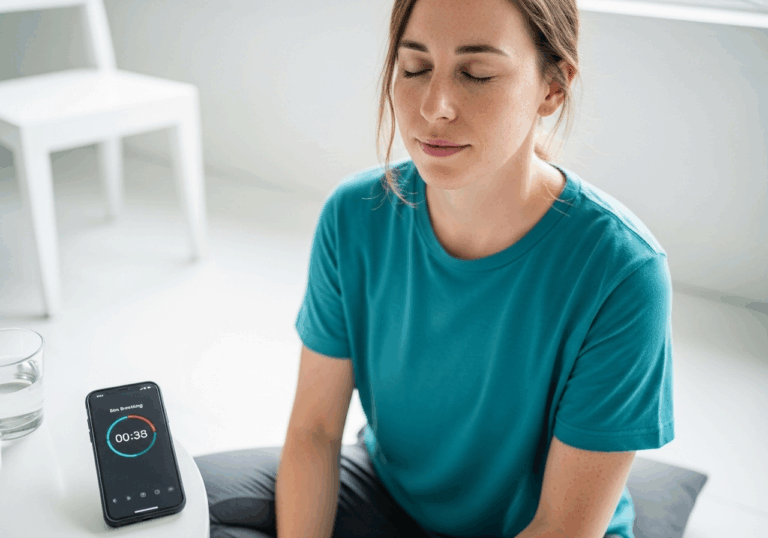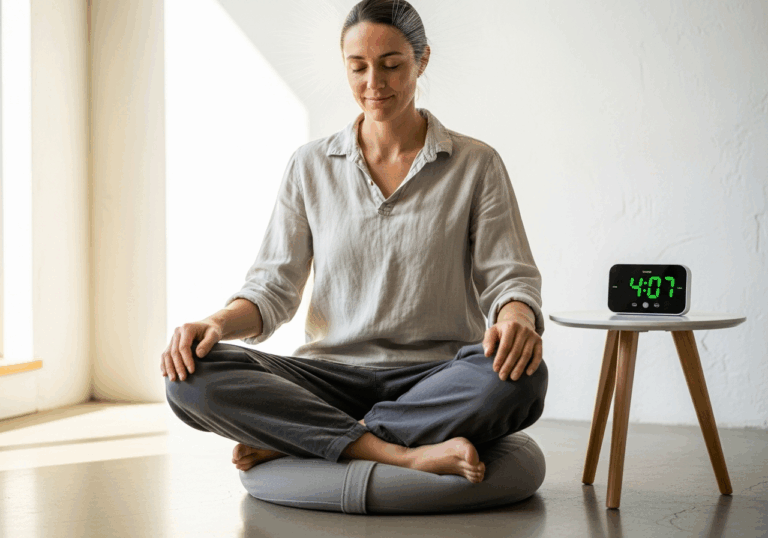Science-Backed Tips
Boost Your Mood with Resonance Frequency Breathing
Experience a 30% increase in positive emotions through paced breathing.
📊 Did you know?
💡 Why It Matters
1️⃣
Paced breathing can lead to a 30% increase in positive emotional states, enhancing overall wellbeing.
2️⃣
Improved HRV coherence is linked to better stress management and emotional regulation.
3️⃣
Regular practice of resonance frequency breathing can contribute to long-term mental health benefits.
✅ Try These Micro-Tips
🎯
Practice resonance frequency breathing for 10 minutes daily to enhance emotional stability.
🎯
Engage in 20-minute sessions of breath-focused biofeedback to improve HRV coherence.
🎯
Incorporate breathing exercises into your morning routine for better mood throughout the day.
🎯
Use a biofeedback app to track your HRV and emotional states during breathing exercises.
📚 The study
Participants who engaged in this rhythmic breathing experienced a remarkable 30% increase in positive emotional states, showcasing the profound impact of simple breathing techniques on mental health.
The findings underscore the importance of HRV coherence, which is linked to improved stress management and emotional regulation. Regular practice of resonance frequency breathing not only fosters immediate emotional uplift but also contributes to long-term mental health benefits. This large-scale evidence highlights how integrating paced breathing into daily routines can serve as a powerful tool for enhancing overall wellbeing.
As we navigate the complexities of modern life, adopting such practices can empower individuals to take charge of their emotional health, leading to a more balanced and fulfilling existence.
❓ Frequently Asked Questions ❓
Learn more
What is resonance frequency breathing?
Resonance frequency breathing involves breathing at a rate of approximately 0.1 Hz, or about 6 breaths per minute. This practice has been shown to enhance heart rate variability (HRV) coherence and improve emotional states.
How does resonance frequency breathing affect emotional well-being?
Research indicates that resonance frequency breathing can lead to a 30% increase in positive emotional states. This enhancement in emotional well-being is linked to improved HRV coherence.
What is HRV coherence and why is it important?
HRV coherence refers to the synchronization of heart rate patterns, which is associated with better stress management and emotional regulation. Higher HRV coherence is linked to enhanced emotional stability and overall well-being.
How long should I practice resonance frequency breathing?
It is recommended to practice resonance frequency breathing for at least 10 minutes daily to experience its benefits. Regular practice can contribute to long-term improvements in mental health.
Can I use a biofeedback app for breathing exercises?
Yes, using a biofeedback app can help you track your HRV and emotional states during breathing exercises. This can provide valuable insights into your progress and enhance the effectiveness of your practice.
What are the benefits of incorporating breathing exercises into my routine?
Incorporating breathing exercises into your morning routine can improve your mood throughout the day. This practice can also lead to better emotional stability and stress management.
How does paced breathing improve stress management?
Paced breathing techniques, such as resonance frequency breathing, help regulate the autonomic nervous system, leading to reduced stress levels. Improved HRV coherence from these practices supports better emotional regulation.
Is there scientific evidence supporting the benefits of resonance frequency breathing?
Yes, a large-scale analysis of 1.8 million app sessions demonstrated that resonance frequency breathing significantly increased HRV coherence and positive emotional states. This evidence supports the effectiveness of paced breathing for enhancing emotional well-being.
What is the recommended duration for breath-focused biofeedback sessions?
Engaging in 20-minute sessions of breath-focused biofeedback is recommended to improve HRV coherence. Longer sessions can provide deeper insights and benefits for emotional regulation.
How can I start practicing resonance frequency breathing?
To start practicing resonance frequency breathing, find a quiet space and focus on breathing at a rate of 6 breaths per minute. You can use a biofeedback app to guide you and track your progress.





